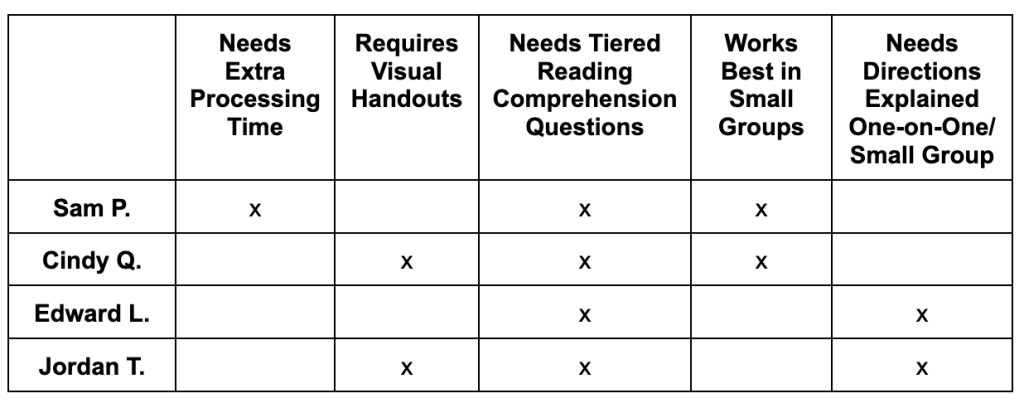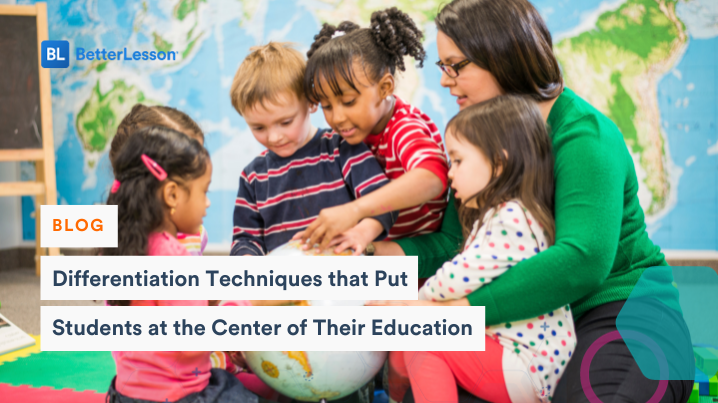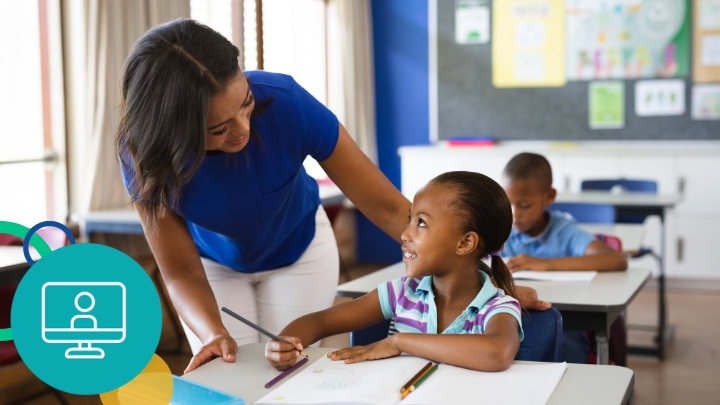Impactful teaching requires a great deal of pedagogical skills. One skill that is sure to translate to effective teaching is differentiated instruction. Differentiated instruction is a pedagogical approach that tailors teaching methods and content to meet the diverse needs of ALL students. It promotes inclusivity, fosters engagement, and ultimately enhances student learning. In this blog post, we’ll explore some strategies for differentiated instruction as shared by exemplary teachers who have honed their craft over the years.
Why Differentiated Instruction
Teachers are charged with a remarkably difficult task: meeting the needs of each student. On the surface, this sounds simple enough. However, any teacher will tell you it is anything but. How does a mathematics teacher ensure, for example, that the student who struggles with addition and subtraction and learns best through visual examples and the student who excels at long multiplication and learns best through collaborative practice BOTH have access to classroom instruction that advances their learning?
While the answer to that question is difficult and complex, it is a necessary question with which teachers and school leaders must grapple. Why? Because every student deserves a high-quality education. Every student deserves the opportunity to be both challenged and supported. And while this pursuit is demanding, it’s entirely possible when teachers are equipped with effective differentiation strategies.
Drawing from BetterLesson’s Meeting the Needs of All Learners Learning Domain, let’s dive into some of those strategies, with specific examples of each strategy.
Strategy #1: Get To Know Your Students
The first and most fundamental strategy to differentiate instruction: Get to know your students. Take the guesswork out of differentiation by carefully studying each student’s needs. Study students’ IEPs, identify trends in classwork, talk with colleagues who previously taught your group of students, and reflect on student engagement patterns. Once teachers have a thorough understanding of what it is exactly that each student needs, then they can begin effectively differentiating their instruction.
Example: Student Needs Guide
One way to systematically get to know student needs is to create a Student Needs Guide. This guide can serve as a one-stop-shop for organizing student academic needs and effective differentiation strategies. A Student Needs Guide might look something like this:

Creating a Student Needs Guide is significant work upfront, but once this critical information is organized, teachers can quickly and impactfully create differentiated learning materials and make instructional decisions that best align with student needs.
Strategy #2: Self-Assessment
Oftentimes, teachers might be racking their brains for information that students themselves know. In the case of differentiated instruction, it can be incredibly helpful to take time to simply ask students about their learning preferences, academic needs, areas in which they excel and areas in which they struggle. Not only is this critical information for teachers, but it allows students to develop skills around self-advocacy and reflection. It also opens up dialogue down the line for conversations about academic concerns and support needs.
Example: Interest Survey
Utilizing Interest Surveys is a quick and systematic way to gather information from students about their own needs and preferences. These surveys can include questions about students’ academic needs as well as get-to-know-you questions that help develop holistic perspectives of their students.
Strategy #3: Vary Assessment Methods
Because we know students learn best in different ways, we also know that students demonstrate their learning best in different ways. If teachers primarily assess learning through one specific method (i.e. open response exit tickets), and some of their students demonstrate their learning best through verbal sharing and others through multiple choice questions, then they might have a skewed understanding of their students’ level of learning. Varying assessment methods ensures a more accurate and holistic understanding of student understanding, and as such, provides clearer data to inform differentiation strategies.
Example: Assessment Happy Hour Menu
The Assessment Happy Hour Menu offers students autonomy in how to demonstrate their learning. For example, at the end of a unit, teachers might curate a list of assessment options (i.e. reflective essay, verbal report/speech, poster board, etc.) and allow students to choose their own assessment. This strategy has multiple benefits: 1. It ensures that students have the opportunity to self-select assessment options that most closely align with their learning needs and preferences; 2. It gives teachers a more accurate window into student learning; and 3. It creates an environment that honors students’ autonomy and voice.
Strategy #4: Use Flexible Grouping
Organizing students into intentional groups can be a very effective differentiation strategy. Sometimes, whole group instructions means that students whose needs aren’t being addressed slip through the cracks, while individualized teaching can be too time-consuming and cumbersome. As a happy medium, flexible groups allow teachers to offer targeted support and students to receive needs-aligned practice. There are a number of ways teachers can engage students in flexible group instruction and practice.
Examples: Using Data to Group Students & Mild, Medium and Spicy Strategic Grouping
Using Data to Group Students: For groups to be successful, they must be made with intention and purpose. One way to create effective groups is by using student data to inform groups. For example, if an English Language Arts teacher is creating a lesson where students practice reading comprehension, the teacher might review recent data (i.e. class work, unit assessments, standardized test data, etc.) to understand students’ current levels of reading comprehension. From there, the teacher could make informed decisions about whether to form homogeneous vs. heterogeneous groupings, what sort of targeted practice each group might need, or what reading levels might be appropriate.
Mild, Medium and Spicy Strategic Grouping: This is a more specific data-driven approach to group instruction/practice. With this strategy, teachers use data to group students into homogeneous proficiency levels: mild, medium, and spicy. This allows teachers to offer targeted support and practice to students at all levels, ensuring that every student is appropriately challenged and supported. The clever framing of these groups – mild, medium, and spicy – can also neutralize or destigmatize proficiency groups, avoiding potentially harmful labels like “beginner,” “intermediate,” and “advanced.”
Strategy #5: Tier Assignments with Clear Expectations
Not every student needs to complete the exact same assignment. On the contrary, sometimes students benefit from tiered assignments. This can allow some students to practice higher-level exercises while others can practice more fundamental skills. Similarly, this can allow students to focus on topics that align with their greatest areas of struggle, gaining meaningful and necessary practice.
Example: W.I.N. (Whatever I Need)
The W.I.N. strategy combines both tiered, targeted practice with student choice. Essentially, teachers set aside a block of instructional time where students self-select particular topics and concepts with which they struggle. Teachers will prepare practice assignments that address various topics within a unit of study. If students are familiar with the Mild, Medium and Spicy Strategic Grouping strategy, this could be an added layer of differentiation: various levels of difficulty within each topic.
When students select their appropriate assignments or activities, teachers might allow them to work either independently or with students who chose the same assignments.
Teachers can also use this time to offer more individualized support to students.
Strategy #6: Incorporate Technology
Technology can be a powerful tool for differentiation. When used with clear intention and purpose, it can meaningfully engage students, offer personalized practice, streamline processes, and build students’ critical digital literacy skills.
Examples: Digital Assessment Tools and Game-Based Tools & Gamified Instruction
Digital Assessment Tools: Technology offers the unique opportunity for students to receive immediate, personalized, and actionable feedback through digital assessment tools. In other words, when teachers use various digital assessment tools, both teachers and students have access to relevant information that can inform future targeted practice and instruction. Within this strategy, there are a variety of tech tools that teachers might utilize to integrate digital assessments in their classroom.
Game-Based Tools and Gamified Instruction: Game-based learning is an engaging approach learning that offers a wide range of benefits: students learn how to navigate new digital resources, students practice academic content in new ways, and teachers have access to real-time data that can inform future differentiation practices. Within this strategy, there is a list of tech tools that teachers might use to gamify (and differentiate!) their instruction.
Strategy #7: Take a Break
Differentiation strategies don’t only have to apply to a particular group of students; rather, differentiation can – and often should – be applied throughout all aspects of teaching and learning. With that, a basic and general strategy to support all learners is this: take a break! Students shuffle from classroom to classroom, solving complicated algebraic equations one minute then identifying the theme in a short story the next. For students who take more time to process information, who are susceptible to fatigue, who struggle with emotional regulation – for all students – intentional breaks can offer the reprieve required to effectively engage in academic content.
Example: Brain Breaks
Brain Breaks are a structured approach to offering students a break from academic instruction. These are short, structured movement-based activities that can break up longer activities or periods of instruction. Brain breaks can effectively increase student concentration levels and decrease stress levels.
Strategy #8: Emphasize Progress over Perfection
This strategy is more about perspective. Teachers can feel significant internal and external pressure to improve student learning outcomes, sometimes to an unrealistic degree. This can cause substantial stress for teachers and students alike. Instead, a powerful differentiation perspective can be to emphasize progress over perfection. The immediate goal of differentiation is not mastery, it is progress. As such, teachers and students need to take time to celebrate progress. For students, this can boost their morale and confidence, increasing their capacity and motivation to engage in academic content. For teachers, this can be a refreshing reminder that their work matters – that it is impactful.
Example: “This Week, I Am Proud Of…”
With this strategy, teachers set aside time each week for students to reflect on an aspect of their learning that they want to celebrate. Maybe a student was able to conjugate a list of Spanish verbs independently for the first time, or maybe a student was able to identify incomplete sentences in their own writing. These improvements deserve to be celebrated. At the end of each week, teachers can have students (in writing, in small groups, as a whole group) complete the following sentence: This week, I am proud of ____. Increasing self-confidence is a critical component of differentiation, and creating time for students to reflect on and acknowledge their own progress can dramatically improve student confidence.
These strategies offer a glimpse into the thousands of instructional strategies and resources that BetterLesson provides. In addition, BetterLesson provides a range of personalized professional learning opportunities – one-on-one coaching, learning walks, in-person and virtual workshops – that can support and improve your school’s approach to differentiated instruction.
Schedule a call with us today to learn more about how we can work together to take differentiation to the next level at your school!
Get in Touch







